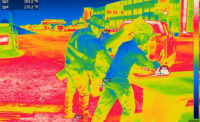Heat may get the headlines, but a study from the London School of Hygiene & Tropical Medicine found that cold weather is 20 times as deadly as hot weather. That study corroborates a U.S. study that found cold kills more than double the number of Americans as heat does.
The fact is, low temperatures can cause more problems for the body’s cardiovascular and respiratory systems that high temps. So it should come as no surprise that prolonged exposure to cold injured 380 workers in the U.S in 2014. But just because weather patterns are unpredictable and cold may be constant doesn’t mean worker illnesses, injuries and fatalities must be as well. Coupled with the right controls and proper personal protective equipment (PPE), this number can be reduced to a familiar wintertime temperature: zero.
Early warning signs
When the body temperature drops below 98.6 degrees Fahrenheit, blood begins to flow away from extremities to help heat the core. This immediately cools exposed skin and extremities, and increases the risk of cold stress, specifically frostbite and hypothermia. According to the Centers for Disease Control and Prevention (CDC), early signs and symptoms of heat loss include shivering, fatigue and confusion/disorientation. They can evolve to blue skin, a slow pulse, and even a loss of consciousness!
If body temps continue to fall, dexterity is diminished and speech may be slurred. At 85°F, severe hypothermia – a condition characterized by extreme low body temperature – sets in. Hypothermia symptoms include cool skin, severe shaking and memory lapses, among other things. Once body temperature plummets below 78°F, a person is at risk for brain damage (and even death!) If not treated immediately.
Extreme exposures
The reality today, however, is that work doesn’t stop just because the temperature drops. So, workers in the winter construction, agriculture, maritime, and commercial fishing industries are often exposed to the most extreme risks. And cold stress is not exclusive to outdoor workers. Those who work in cold storage or food processing, as well as those in facilities without heat or insulation, are also at risk. But by following a few common sense cold stress and winter safety tips, keeping comfortable is manageable.
- Every jobsite that does wintertime or cold exposure work should develop a cold stress prevention plan. Supervisors should know the signs and symptoms of cold-related illnesses as well as the proper response, and remind their workers of those during daily or weekly safety briefings. They should also provide comprehensive cold stress training and a heated space for workers to take breaks.
- Try to plan for shorter shifts – adjust work schedules or rotations to the cold or changing weather. Schedule shifts in the middle of the day – take advantage of the solar heat load that accumulates on sunny days.
- Hang a few cold stress cards or posters around your office/meeting room for workers to reference before they head out into the bitter chill. Being prepared to face the elements is key.
- Workers should abide by the buddy system and keep an eye out to see if their fellow crew members are exhibiting any cold stress symptoms. The responsibility doesn’t begin and end with supervisors.
Dress for success
It may be a last resort in the Hierarchy of Controls, but wearing proper PPE can help. Workers can prevent cold stress by layering and choosing the right garments, clothing that is insulating, but won’t retain moisture and become heavy.
Here’s what workers should keep in mind when layering:
- Inner Layer: Should be the first layer of insulation and keep moisture away from the body. Consider thermal wear or garments made of wool, silk, or a synthetic like polypropylene that hold more body heat than cotton.
- Middle Layer: Should provide a second layer of insulation, even when wet. Consider wool or synthetic garments.
- Outer Layer: This is the first layer of defense against the elements and should allow ventilation to prevent overheating while also protecting from wind and rain to keep the wearer dry.
To protect extremities, choose boots and gloves that are insulated and waterproof. Winter work gloves (i.e., thermal gloves) can increase productivity by keeping workers’ hands comfortable without sacrificing dexterity. Reach for headwear that will cover the ears and head. Wearing a knit mask or a heat exchanger mask to cover the face and mouth is also a good idea.
Getting the job done in bitter cold conditions isn’t about “toughing it out.” It’s about planning ahead, taking regular breaks to get warm, and layering up in the right PPE. Don’t wait until it’s too late to make your cold stress prevention plan.
Read Ergodyne’s cold stress white paper and OSHA’s Cold Emergency Preparedness Guide for more best practices on working through winter’s worst.



